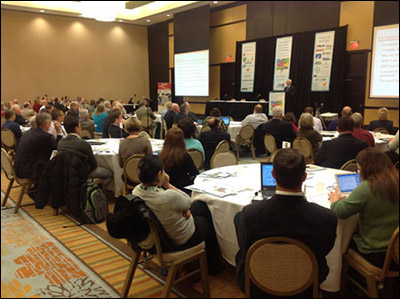Antibiotic Use, Resistance Calls for Collaborative ‘One Health’ Approach
Symposium coordinated by NIAA emphasizes need for collaboration of human, animal and environmental health communities to address issues and find solutions.

Lonnie King, dean of the OSU College of Veterinary Medicine, keynotes the 2012 national symposium on antibiotic use and resistance.
The message emerging from the “A One Health Approach to Antimicrobial Use & Resistance: A Dialogue for a Common Purpose” symposium, Nov. 13-15, in Columbus, Ohio, was clear: Antibiotic use and antimicrobial resistance are the responsibility of all communities — human, animal and environmental health — and solutions will require collaboration of these health communities.
At the end of the three-day symposium, which was coordinated by the National Institute for Animal Agriculture (NIAA), presenters and participants agreed on numerous points:
- Antibiotics dramatically improve human, animal and plant health, and increase life expectancy.
- Antimicrobial resistance is not going to go away. A historical look at antimicrobial resistance shows antimicrobial resistance is not a new phenomenon, but existed before mankind.
- The topic of antimicrobial resistance can be subtle, complex, difficult and polarizing. It is more than science and evidence. It’s about politics, behavior, economics and conflicting opinions.
- Antimicrobial resistance is not merely a consequence of use; it’s a consequence of use and misuse, and each community — animal health, human health or environmental health — is responsible for antibiotic stewardship.
- The finger-pointing and blame for antimicrobial resistance needs to end. The time has come to work together.
“Finding a solution is not about compromise; it’s about reaching agreement,” stated Lonnie King, dean of the Ohio State University College of Veterinary Medicine. “We (animal health, human health and environmental health communities) need to focus on interests and not positions and initiate options for mutual gain. We need to find common ground, something we all can agree to when we disagree on other issues.”
Topics addressed by the 13 experts during the symposium covered:
- overview of antibiotic use;
- history of antimicrobial resistance;
- antimicrobial resistance surveillance;
- environmental contamination with antimicrobial residues;
- interplay of animal and human antimicrobial-resistant populations;
- nationally funded antimicrobial-resistance research projects; and
- alternatives to antibiotics in agriculture.
“The symposium’s four interactive sessions allowed presenters and attendees to provide input to questions that moved the group to consensus,” stated Leah Dorman, co-chair of the symposium and director of food programs at the Ohio Farm Bureau. “In the end, it was extremely evident that the dialogue among the animal health, human health and environmental health communities is critical to a solution.
“A ‘One Health’ approach is important. Plus, we need [to] think in a much larger dimension,” Dorman added.
Jennifer Koeman, symposium co-chair and director of producer and public health with the National Pork Board, agreed, adding, “It’s about mutual gain and not a victory for any one community.”
Presentations by symposium speakers will be available online at www.animalagriculture.org. A white paper is being developed and will be available online at NIAA’s website as well.
Editor’s Note: This article was provided by NIAA. The organization provides a forum for building consensus and advancing proactive solutions for animal agriculture — the beef, dairy, swine, sheep, goat, equine and poultry industries — and provides continuing education and communication linkages for animal agriculture professionals. NIAA is dedicated to programs that work toward the eradication of disease that pose risk to the health of animals, wildlife and humans; promote a safe and wholesome food supply for our nation and abroad; and promote best practices in environmental stewardship, animal health and well-being.

[Click here to go to the top of the page.]








